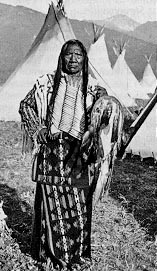
Chief Charlo (1910)
But in 1872 a new treaty was made and signed. This treaty shrunk Flathead land to the size of the current Flathead reservation in northwestern Montana. The primary chief of the Flatheads, Chief Charlo, claimed he did not sign the treaty of 1872. James Garfield, the treaty negotiator and future president of the United States, claimed he had obtained Charlo's signature. Thus the Flathead land of the Bitterroot Valley was lost to its original owners.
The Flatheads had been converted to Catholicism and St. Mary's Mission was located close to them in nearby Stevensville. The band numbered around 550 people at this time ' including about 25 Nez Perce. The Flatheads and Nez Perce had a long history of friendship and had intermarried. It was natural that the Nez Perce would expect to camp with their old friends.

Chief Charlo (1910)
On reaching the place of Charlos, the Flathead chief, Looking Glass summoned a number of his warriors to accompany him to visit Charlos and inquire of him where the best place to camp was to find good grass. On approaching Charlos' house Looking Glass thought it would be honorable to extend his hand to Charlos before making his inquiry. But Charlos refused to accept the extended hand saying, 'Why should I shake hands with men whose hands are bloody? My hands are clean of blood.' Looking Glass replied: "Your hands are as red with the blood of your enemies as mine are. Why should my hands be clean when I have been forced to fight the white man? Your hands are as bloody as ours. I did not come to talk about blood. I came to ask you the best place to camp." Charlos answered: 'Above my house is the best spot to camp.' And there they accordingly pitched their tents.
Duncan McDonald
It was my father's boast that his hand had never in seventy years been bloodied with the white man's blood, and I am the son of my father.
We could not fight against the Nez Perces because they helped me several years ago, against my enemy the Blackfeet, but we will not fight with them against the whites.
Chief Charlo
Flathead
Both Nez Perce and white were angry at Charlo because he walked the tightrope of neutrality. Twenty Flathead warriors, wearing white handkerchiefs around their heads, had stood with the Bitterroot citizen volunteers at Fort Fizzle. Now the Nez Perce were camping with Charlo while they did some trading in Stevensville. Although several settlers realized Charlo's beneficial role, he received no thanks for his role as mediator. In 1891, Charlo was ordered off the parcel of land which had been surveyed for him and forced to move onto the Flathead reservation.
The Nez Perce Flight to Canada - An Introduction